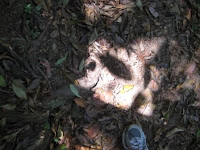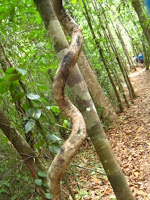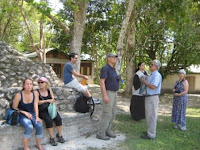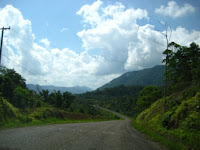
Other Training Sessions and Activities
On Fridays, when the trainees come to the office, it’s generally a day for me to try to catch up on session plans and trainer evaluations and other work, but usually it just means doing a few small things and sitting in on sessions and training staff meetings. Having everyone in the office makes it super busy and it's difficult to get a lot of work done.
A couple of the major sessions are really fun to participate in. Aside from all the medical and safety and security sessions, we still include some general PCV-work related topics and the PTO does a series on development.
One major activity I love is on working with groups which provides experiential learning to highlight some of the stages of group development, as well as some of the challenges that can be faced when working in groups. We first have the trainees split up and give one set a string and a task to make a circle while the second group observes and takes notes. Then, the second group has to do the same thing, only they are blindfolded and can’t talk. It’s fun to watch and see how they interact and accept the challenge. Oftentimes, the ones who can’t see or speak do better because they don’t have to compete with each other and have everyone try to be the leader and no one follow! It’s a good one.
Following that is the big challenge of the spider web. All trainees have to get through a large spider web. Each opening can only be used one time and trainees cannot touch any part of the web while passing through. This group really took a long time to strategize (I have not seen a group do that before, but it also came from one of my trainees who was heavily involved in student activities and has done similar things like this before, I was so proud!). After over 30 minutes of deliberating, a plan was set and the passing began – there were mishaps and people had to start again for touching the rope, but after another hour, they all made it through successfully.
We debrief the activities and talk about stages of group formation (forming, storming, norming, and performing) and about leadership roles and challenges. We ask them to connect this to working with groups in Belize and their experiences thus far with Belizean groups. It’s a great activity!
My other favorite is Site Assignment Day! We do this toward the end of CBT because it gives time for program managers to really make the strongest match between project needs and trainee skills and personality. We like to make the reveal big and exciting – the trainees spend the entire time prior to this day trying to figure out where they are going and hounding us trainers and LCFs for information. I purposefully do NOT get final site information so I don’t have to hide anything! Erin, the other PTS, who is artistic and creative, made a giant map of Belize and printed out PCT pictures and posted them on the map in their future sites. The entire training staff made up over 150 Taboo cards for a massive game of Site Assignment Taboo.




























 After the ruins, the girls from Dangriga stayed on to continue the fun with lunch in San Ignacio and ice cream in Spanish Lookout. We had a nice day and then it was back to Belmopan for the Agriculture and Trade Show (which Anthony and I went to on Sunday, later post about that to come!).
After the ruins, the girls from Dangriga stayed on to continue the fun with lunch in San Ignacio and ice cream in Spanish Lookout. We had a nice day and then it was back to Belmopan for the Agriculture and Trade Show (which Anthony and I went to on Sunday, later post about that to come!).



















